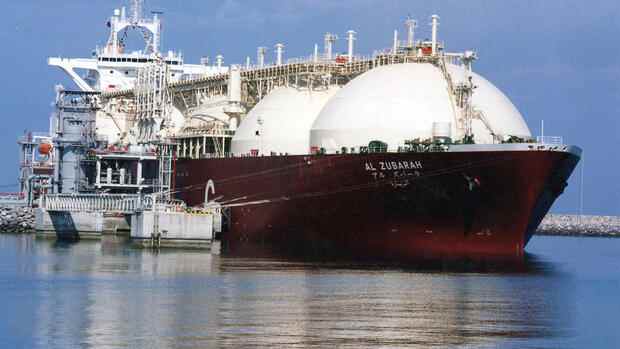Ottawa For Robert Habeck, one thing is clear: Germany must become independent of Russian gas. In his global search for new sources of energy, “friendly Canada” is now also on the Federal Minister of Economics’ priority list, as he recently stated after a meeting with the Canadian Minister of Economics and Innovation, François-Philippe Champagne. A central point is the supply of liquefied natural gas (LNG) to Germany.
The message got through, the Canadian Natural Gas Association confirms. There is a lively exchange with the European embassies. It is about helping Europe out of the energy dilemma, they say. More specifically, the Canadian energy company Pieridae Energy Ltd. headquartered in Calgary. The group is considering reviving plans to build an LNG terminal on the Atlantic coast for exports to Germany.
Last summer, Pieridae abandoned plans to build a terminal on the coast of the Atlantic province of Nova Scotia for cost and time reasons. Chief Executive Officer Alfred Sorensen had declared at the time that he wanted to take “a new direction”. “The world has changed a lot,” says Sorensen now and pulls the old plans out of the drawer again.
Another terminal of the Spanish group Repsol in St. John in New Brunswick is already working. So far, however, it can only be used for imports. According to CGA President Timothy Egan, consideration is currently being given to converting the terminal so that it can also be used for exports.
Top jobs of the day
Find the best jobs now and
be notified by email.
But this will also take several years. A short-term solution to Germany’s energy concerns is not in sight – but Canada at least offers a long-term perspective.
There is only one LNG terminal on the west coast
With its enormous resources, which Canada’s government and the Canadian Gas Association (CGA) state at 39 trillion cubic meters, and its annual production of 170 billion cubic meters, Canada is the fifth or sixth largest natural gas producer. But only on the west coast is a terminal for exports to Asia nearing completion. Canada, on the other hand, currently has no terminals on its east coast to export liquefied natural gas (LNG) across the Atlantic to Europe.
“Canada has natural gas, but cannot bring its LNG to Europe,” the Canadian daily Globe and Mail stated in January 2022, a month before the start of the Ukraine war. And Tim McMillan, then president of the Canadian Petroleum Producers Association (CAPP), ruled in late February that Canada had missed an opportunity to bring natural gas to world markets in the form of liquefied natural gas. Because almost all proposed LNG projects have been abandoned. In contrast, the US completed seven LNG plants between 2014 and 2020. More are under construction.
Now the Canadian government is in talks with Pieridae and Repsol to explore how the two LNG projects can be accelerated in order to increase shipments to Europe, according to Raw Materials Minister Jonathan Wilkinson. According to Canadian media, Sorensen announced a new feasibility study on LNG exports to Germany.
Canada is seen by Europeans as a partner in energy security. “Canada can help provide the resources that Europe needs,” Canada’s ambassador in Berlin, Stéphane Dion, told Handelsblatt. “We cannot build terminals overnight. But we’re already helping,” said Dion.
This happens at least indirectly. Canada currently exports around 80 billion cubic meters of natural gas to the United States annually, about 40 percent of its production. As such, Canadian natural gas is either part of the gas now coming into Europe from the US, or the US is able to send its own natural gas to Europe because of Canadian supplies. “The quickest way to help Europe right now is to ship more Canadian natural gas to the US,” said CGA President Egan.
Cooperation is expanded
The CGA is in talks with the German embassy and the other European embassies in the Canadian capital. In mid-June, at the invitation of the EU ambassador in Ottawa, the representatives of almost all EU countries spoke to the CGA about future gas policy. “The message from the Europeans is: We want to develop relations,” says Egan. This also applies to cooperation in hydrogen technology.
Cooperation between Canada and Germany has been expanded in recent months with several agreements at government level. In March 2021, Canada and Germany signed a “Memorandum on an Energy Partnership”. A steering group for bilateral cooperation was set up in September 2021 and met for the first time in mid-May 2022.
>> Also read here: A new beginning in trade policy – Germany makes new agreements possible
Discussions focused on a coordinated response to Russia’s incursion into Ukraine and cooperation on energy security and supply of critical minerals and metals to industry. In addition, there is the “Partnership for Raw Materials” founded in June 2021 at European level, which is intended to secure the supply chain for minerals and metals.
There is also an EU-Canada working group founded by EU Commission President Ursula von der Leyen and Prime Minister Trudeau in March 2022. She deals with the topic of energy security. Energy security was probably also a topic of the talks that Trudeau had with Chancellor Olaf Scholz at the G7 summit.
Should Pieridae build an LNG terminal, up to ten million tons of natural gas per year could be brought to Germany, with the smaller solution, a floating terminal, it would be 2.5 million tons, according to the Canadian media. And full absorption of exports would then be possible in 2028.
More: Canadian natural gas is only enough for an LNG export plant to Europe
